The Coronation of a British monarch is a grand event steeped in tradition and history. With the recent Coronation of King Charles III on 6 May 2023, it’s the perfect time to explore the key rituals and ceremonies that take place during this momentous occasion. Join us as we delve into the fascinating world of a British Coronation and discover the significance of each ceremony.
Procession from Buckingham Palace to Westminster Abbey
Coronation day begins with a procession from Buckingham Palace to Westminster Abbey, a majestic display of pageantry and splendor. The new monarch, accompanied by the royal retinue, travels through the streets of London to be greeted by well-wishers.
The King’s or Queen’s Procession
Upon arriving at Westminster Abbey, the monarch and royal retinue undergo the second procession of Coronation Day where they pass by notable figures in British and international governance, pop culture, and so on. This includes heads of state, representatives of the Houses of Commons and Lords, archbishops, bishops, and other notable guests.
The Coronation Ceremony
The highlight of the Coronation is, of course, the Coronation Ceremony itself. This solemn and symbolic event can be further broken down into several parts such as the Recognition and Oath, Anointing, Investiture and Homage.
During the Recognition and Oath, the monarch is formally presented as such to the congregation by the Archbishop of Canterbury. They will then take the Coronation Oath, before sitting in the Coronation Chair.
Once the monarch is seated, the Anointing begins. This is one of the most sacred moments in a British Coronation. The monarch is anointed with holy oil on their head, chest, and hands using the Coronation Spoon, symbolising the divine consecration of their reign. This ancient ritual harks back to biblical traditions, mirroring the anointing of kings in the Old Testament. It also symbolises the monarch’s position as the Head of the Church of England, a position that’s been entertwined with the modern British monarchy since the Tudor era.

Once the Anointing is complete, the monarch undergoes the Investiture, where they are draped in special robes and regalia. The regalia used during the Coronation holds deep historical and religious significance, representing the sovereign’s authority and divine right to rule. These include gold jewellery, the Sword of Offering, and the Sovereign’s Orb. Finally, the monarch is crowned with St. Edward’s Crown – an iconic symbol of the British monarchy for its rich purple velvet. Some of these robes and regalia can be seen in this H.M. Queen Elizabeth in Coronation Robes figurine, depicting Queen Elizabeth The Queen Mother (Mother of Queen Elizabeth II, and grandmother of King Charles III) in the outfit worn during her own Coronation in 1937.
After these ceremonies are complete, senior officials pay homage to the newly crowned monarch and the process is repeated for the monarch’s consort as well.
Procession from Westminster Abbey to Buckingham Palace
Coronation Day proceedings are brought to a close with a final procession from Westminster Abbey to Buckingham Palace. Upon reaching the Palace the monarch is presented to the crowd, accompanied by other members of the royal family. This year in 2023, a flypast from the Royal Air Force was also carried out.
Connect with History at the MINT Museum of Toys
Coronations have taken place in Great Britain and the United Kingdom for over 1,000 years but the exact process detailed above has only roughly been in place since 1902 with the Coronation of King Edward VII. Visitors to our museum who are interested to see what past Coronations looked like can behold a collection of valuable vintage toys depicting key aspects of the 1953 Coronation of Queen Elizabeth II. From a ‘Coronation of Her Majesty Singapore Programme’ booklet to the figurine featured above, these toys provide a tangible link to such a historic event, allowing visitors to experience a piece of the past in front of their very eyes.
If you’re hoping to host a once-in-a-lifetime event that channels the excitement of a Coronation, look no further than the private event venue rentals here at the MINT Museum of Toys. From party venues to wedding event spaces, our cheap and affordable premises will make your occasion truly memorable without needing to break your budget. We also offer pop up exhibition display spaces in Singapore through our UNBOX programme. This gives collectors and creators to share their interests with our audience, showcasing any toy, collectible, or memorabilia they’re passionate about. Get in touch with our team for more information today.
Join the MINT Museum of Toys in celebrating the magical world of Disney as we mark the momentous occasion of Disney’s 100th Anniversary. From its humble beginnings to becoming a global phenomenon, Disney has captured the hearts of audiences young and old. Let’s explore some of the highlights in Disney’s remarkable journey over the last ten decades:
1. The Birth of an Entertainment Empire (1920s)
Steamboat Willie was released in November 1928, marking the first-ever appearance of Mickey Mouse and the beginning of a legend. It was the first cartoon released with synchronised sound, reflecting the Disney company’s boundary-pushing creativity and risk-taking in animation.
2. The Golden Age of Animation (1930s)
In 1937, the Walt Disney Company introduced the world to its first-ever full-length animated feature film, “Snow White and the Seven Dwarfs”. This groundbreaking movie was the highest-grossing film of all time at that point in time, set a new standard for animation, and launched Disney’s legacy of enchanting storytelling. It showcased the artistry and innovation that would define Disney’s animation style for years to come and set the standards for other animation companies to follow.



Maker: Margarete Steiff GmbH
Year of Make: 1930s
Material: Fabric
Country of Origin: Germany
Maker: Knickerbocker Toy Co. Inc.
Year of Make: 1930s
Material: Fabric
Country of Origin: United States of America
Maker: Dean’s Rag Book Company Ltd.
Year of Make: 1930s
Material: Fabric and Felt
Country of Origin: United Kingdom
As Disney’s star began to rise in the 1930s, so did the amount of stuffed toys and memorabilia made worldwide featuring its most famous cartoon stars. The Mickey Mouse Steiff (Germany), Minnie Mouse in Cowgirl Costume (USA), and Mickey Mouse Jazzer (UK) are just a handful of the Mickey and Minnie toys that began to delight fans all over the world. Take a peek at even more Mickey Mouse memorabilia and vintage toys on our blog, or pay a visit to the Level 2 Collectables exhibition in our toy museum to see the full Mickey Mouse collection!
3. The Patriotic Years (1940s)
Disney was deeply involved in propaganda efforts during World War II and contributed to the war effort with anti-Nazi and anti-Japanese propaganda like 1943’s “Der Fuehrer’s Face”, as well as pro-US propaganda like “The Spirit of ’43” released in the same year. These films showcased Disney’s ability to adapt and contribute to the cultural landscape while recognising the power of animation to reach and resonate with audiences of all ages, not just children.
4. The Birth of Disneyland (1950s)
1955 marked the opening of Disneyland, the now-iconic theme park in California. Walt Disney’s vision of a magical kingdom finally became a reality after years of work, providing a place where families could immerse themselves in the enchantment of Disney’s stories and characters. Half a century later, Disney Parks is now a major business segment and division of the larger Walt Disney Company, with six attractions located worldwide.
5. The Animated Classics (1960s)
The 1960s saw the release of some of the company’s most beloved Silver Age classics, including 1961’s “One Hundred and One Dalmatians”, 1963’s “The Sword in the Stone”, and 1967’s “The Jungle Book”. Sadly, this decade was also earmarked by the passing of Walt Disney in 1966 at the age of 65.
6. The Theme Park Expansion (1970s)
The 1970s saw the expansion of Disney’s theme park empire with the opening of Walt Disney World in Florida in 1971. This sprawling resort offered new attractions, resorts, and the iconic Magic Kingdom, solidifying Disney’s status as a leader in the entertainment industry both on and off-screen.
7. The Era of Blockbusters (1980s)
The 1980s marked several major accomplishments for the company, such as 1983’s opening of Tokyo Disneyland – the first Disney park outside of the USA. However, most notably, in 1989 the company released “The Little Mermaid” – an international success that would mark the beginning of the period known as the “Disney Renaissance”.
8. The Disney Renaissance (1990s)
The Disney Renaissance carried over into the 1990s with “Beauty and the Beast” (1991), “The Lion King” (1994), “Toy Story” (1995), “Mulan” (1998), “Tarzan” (1999), and more. These films were critical and commercial hits, and ended up revitalising Disney’s animated feature department while reflecting the company’s power at reinventing old stories in new ways for an ever-changing audience.
9. The Digital Age (2000s)
In the 2000s, Disney embraced the digital age with groundbreaking films like “Monsters, Inc.” (2001), “Finding Nemo” (2003), and “The Incredibles” (2004). Many of the company’s live-action hits were also released during this decade, from 2003’s “Pirates of the Caribbean: The Curse of the Black Pearl” to 2006’s “High School Musical”.
10. The Live-Action Era (2010s)
The 2010s marked some of Disney’s biggest expansions of its entertainment empire, including acquiring Lucasfilm in 2012 and the reorganisation of Marvel Studios under Walt Disney Studios in 2015. Disney also embarked on a series of live-action remakes of beloved classics, starting with 2014’s “Maleficent” and 2015’s “Cinderella”. These films breathed new life into timeless stories and introduced them to a new generation of fans.
Discover Disney Memorabilia and More at the MINT Museum of Toys
As the world celebrates 100 years of Disney, join us at the MINT Museum of Toys and immerse yourself in the magic of Disney’s rich history. Discover our collection of vintage toys, childhood memorabilia, and pop-up exhibition displays that span the 1840s to 1980s, including cherished Disney characters that have become beloved icons of popular culture.
From extensive toy collections to vibrant pop-up spaces, there’s no other museum for adults or kids in Singapore like us. Book your tickets for our exhibitions today, or explore our virtual museum exhibition from the comfort of home!
Today we’re used to seeing a barrage of movies – live-action, animated, or a mix of both – written specifically for children. Companies like Disney, Pixar, DreamWorks, Universal, and Illumination have become famous worldwide for their endless parade of children’s films and family-friendly films all the way from Snow White (1937) to Sing 2 (2021).
But if we were to travel back in time 100 years, the thought of a children’s entertainment industry would have been laughable. In fact, the concept of a ‘movie’ or ‘cinema’ was only just beginning to come into existence at the time, and it would still take several decades before cinema-going became an everyday activity for the average person.
Journey through the early years of cinema, and discover how the children’s film industry eventually came to be:
1895-1910s: the Early Cinema Experience for Kids
For the first few years of early cinema, children were not the main audience filmmakers were trying to attract. Many films revolved around real-world topics and locations, and were targeted towards adults. Filmmaking was also a costly process and longer or more fantastical films would only become popular later on after advancements such as the British Kinemacolour process (1909) and the growth of national film industries across Europe from 1914 onwards.
Not to mention that kids of that era easily entertained themselves with DIY or outdoor games and toys such as tops, yo-yos, dolls, and card or board games. Radio programs and comic strips were also highly popular amongst children, including franchises such as Buck Rogers and Detective Comics (later DC Comics).
Eventually between 1910-1915, the USA saw a massive proliferation of nickelodeon cinemas. So named because the entrance fee only cost a nickel, nickelodeons bridged the gap between vaudeville and early cinema. Some cinemas only showed films, whereas others interspersed film screenings with vaudeville acts or musical performances.
By 1913, children’s matinees were common in cinemas across the USA and studios were encouraged to make films suitable for a younger audience. Yet despite initiatives by the Motion Picture Producers and Distributors Association (MPPDA) to produce specially edited programmes for kids, it wasn’t until the 1920s that ‘children’s films’ began to emerge.
1920s-1930s: early Children’s Films and their Stars
Popular children’s film genres of the time included short subjects (serial) and cartoons. While these were not seen as ‘proper’ compared to full-scale Hollywood productions, series like the original The Little Rascals (1922-1944) ended up being successful and long-running, and made it clear to studios of the huge commercial value in children’s entertainment.
Gradually more films were produced for child audiences – almost all of which were adaptations of existing fairy tales or children’s stories instead of original plots, such as Heidi (1937) and The Wizard of Oz (1939). Ironically, Hollywood typically avoided casting child stars in films where a child was the main character and opted to cast youthful-looking adults instead. For example, Mary Pickford was 28 years old when she played 11-year-old orphan Pollyanna in the eponymous Pollyanna (1920).

Charlie Chaplin
Maker: Schuco
Year of Make: c. 1920s
Material: Fabric and Lithographed Tin
Country of Origin: Germany
This isn’t to say that there weren’t any child actors. Famous child stars of the time such as Jackie Coogan, Baby Peggy, and Shirley Temple were originally cast in supporting roles alongside adult stars to cater to a wider audience – but later gained media and popular attention for their talents. Jackie Coogan’s role in Charlie Chaplin’s The Kid (1921) turned him into a household name, and Coogan would end up acting all the way into adulthood. Coogan’s popularity was primarily due to his amazing ability to mimic Chaplin – making him the perfect sidekick for a highly independent creator such as Chaplin who always wanted to have sole billing and recognition in his films.
Over time this attitude towards casting would change. Shirley Temple – one of the most famous kid stars of early cinema even today – would even have a feature film Bright Eyes (1934) written specifically to showcase her talents, and she later received a miniature Oscar in 1935 honouring her contributions to Hollywood.
And of course in 1937, Disney’s Snow White and the Seven Dwarfs was released as the first-ever full-length animated movie, marking a turning point in children’s cinema. Children began to emulate their favourite characters such as the Three Stooges, Little Rascals, or Snow White – dressing up as them outside the cinema, and even buying specially-made merchandise.
The commercial success and critical acclaim of these productions (and their assorted memorabilia) cemented the future rise of the children’s entertainment industry – and the rest, as we say, is history.
Discover History through Vintage Toys
The children’s entertainment industry has changed tremendously since the tentative beginnings of early children’s cinema. Today we can even watch an endless assortment of live-action and animated movies in the comfort of home thanks to streaming services like Disney+ and Netflix! Book your tickets and head down to the MINT Museum of Toys in-person to be amazed by our extensive set of Charlie Chaplin vintage toys and memorabilia at our Characters collection on level 4.
See more valuable vintage toys and memorabilia from throughout the years with our virtual museum tours. Explore 2 selected permanent exhibitions – Collectables and Childhood Favourites – through over 100 interactive touchpoints, all from the comfort of home.
Ask anybody today to name a famous animated animal, and you’d probably hear answers like “Mickey Mouse”, “Peppa the Pig”, or even “Arthur (the Aardvark)”. But before any of these childhood mainstays dominated our screens, there was Felix the Cat.
Felix was beloved by audiences for cute appearance, curious attitude, and mischievous grin, and played a pivotal role in creating cartoon tropes we still recognise and love today. The decades of popular animation – for adults and kids alike – that followed could not have been possible without Felix’s trailblazing grin.
Trace the popularity of Felix the Cat throughout the years with us – and make sure to book your ticket today to see more authentic Felix vintage toys at level 4 of the MINT Museum of Toys.
Gradual Stardom
Felix the Cat was designed in 1919 by Pat Sullivan and Otto Mesmer, although his initial prototype “Master Tom” was the first to appear in the November 1919 Paramount Pictures shorts Feline Follies and Musical Mews. With the success of these silent shorts, Master Tom was officially redesigned and renamed as Felix, who made his debut in the December 1919 short The Adventures of Felix.
The Felix shorts were originally distributed by Paramount (1919-21), Margaret J. Winkler (1922-25), Educational Pictures (1926-28), and Copley Pictures (1929-30). As his fame grew and he gained widespread popularity, Felix began to appear in other mediums including a syndicated newspaper strip (1923-66) drawn by Messmer and later his assistant Joe Oriolo, and the Betty Boop and Felix comics (1984-87).
Felix merchandise was also everywhere during his peak popularity, from everyday appliances and toys to the Macy’s Thanksgiving Parade. He was even selected as mascot of the U.S. Navy’s VB-2B (later VF-6B, then VF-3) fighter squadron, with their F-3 biplanes featuring a logo of Felix holding a bomb. Duing the first-ever TV transmission on NBC, a Felix doll was also selected as a test model – truly reflecting his superstar status.
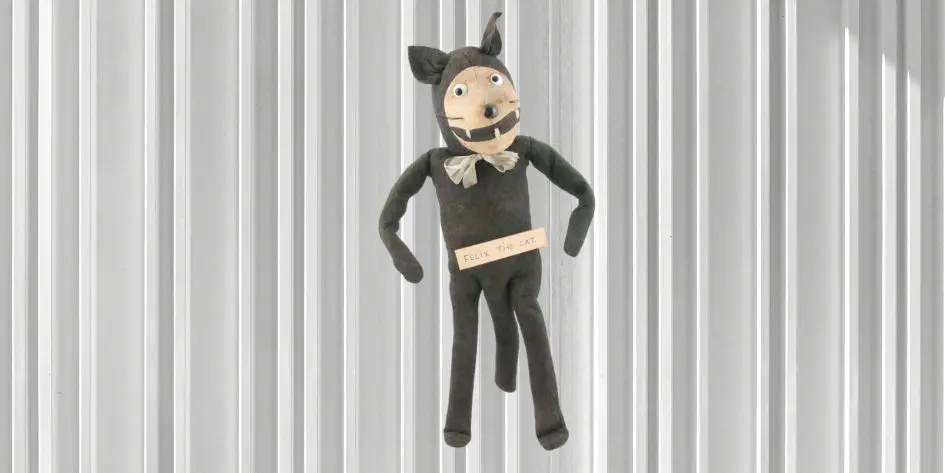
Felix the Cat Fabric Doll
Maker: Schuco
Year of Make: c. 1920s
Material: Fabric
Country of Origin: Germany
Early merchandise like this Felix the Cat Fabric Doll reflect the first designs of Felix, which was more fox-like with angular limbs and features. In 1924, animator Bill Nolan redesigned Felix to make him ‘cuter’ using softer lines, a round and rubbery head and body, and wide eyes. This made it easier for studios to animate Felix and has remained Felix’s design till today.
Makers such as Schuco hopped onto the Felix merchandise trend as Felix’s popularity grew, resulting in not just fabric dolls but tin toys, mechanical wind-up dolls, hand puppets, and other memorabilia such as perfume bottles and plates. These items were produced for both his original design and redesign, keeping up with Felix’s superstar status during the early 20th century.
Diminishing Fame
With the death of Felix co-creator Sullivan in 1933, things got complicated. Coupled with the rise of “talkie” films and the emergence of rivals such as Walt Disney’s Mickey Mouse, Felix’s star was beginning to fade.
In 1936, Van Beuren Studios finally got permission from Sullivan’s brother to license Felix to the studio, intending to produce new coloured shorts with sound. However, Burt Gillet (the head of Van Beuren’s staff) overhauled Felix’s old cheeky personality causing his popular appeal to diminish. The new shorts ended up being retired after just 3 unsuccessful productions.
It wasn’t till decades later that Felix would appear on-screen again, first in Felix the Cat (1958-60, created by Joe Oriolo) and then The Twisted Tales of Felix the Cat (1995-97).
Controversy and Conflict
At times, Felix’s stardom seemed to be overshadowed by the conflicts between his co-creators. Sullivan and Messmer had a long-running dispute between who was the ‘true’ creator of Felix the Cat – especially since Sullivan, as studio proprietor, had automatic copyright to creative work done by employees such as Messmer.
After Sullivan’s death in 1933, his estate took ownership over Felix. However many Sullivan staffers have staunchly claimed that Messmer was the real brainchild between Felix. Many animation historians have also backed up the claim that Messmer was the real creator, as the one who drew and produced the bulk volume of Felix cartoons. Even Walt Disney paid tribute to Messmer in a 1955 program on animation history.
Legacy and Influence
Within the larger world of silent cinema at the time, animated and live-action films were generally grounded in real-world situations and plots. Felix the Cat totally upended this and ushered in the trend of modernism and surrealism in cartoon filmmaking – think objects popping in and out of existence, or an expressive tail that could ‘become’ items or even expressions (e.g. exclamation marks).
Common themes in Felix also echoed contemporary concerns like Prohibition, Roaring Twenties, and cultural touchstones like the Charleston. Some of these issues have sparked discussion and controversy in more recent years with some scholars discussing the influence of minstrel tropes on Felix’s design, but the character is still generally seen as a symbol of classic Americana.
In some circles, Felix has continued to become a niche pop culture icon. He had his own Wendy’s collaboration in the early 2000s and Felix-inspired fashion has even made it onto runways and magazines including Vogue and Cosmopolitan. For Felix’s 100th anniversary in 2019, Universal Pictures declared 9 Nov “Felix the Cat Day”. Limited-edition Felix merchandise was released including Pop! Funko figurines, Skechers shoes, and PEZ dispensers all themed after this iconic cat – and signalling he won’t be forgotten anytime soon.
Discover Pop Culture through Vintage Toys
Learn more about toys during the silent film era and their powerful (yet subtle) impact on history and pop culture with our collection of some of the best loved vintage toys from around the world. Book our virtual museum tours today to explore valuable vintage toys from the comfort of your home, or get your tickets today and come down to see us in person!
In 1929, the Warner Bros. studio was trying to compete with rival Disney’s popular Mickey Mouse and Silly Symphony shorts. As the studio had recently acquired music held by Brunswick Records, they decided to create Looney Tunes and Merrie Melodies using these musical tracks.
Thus began the legacy of Looney Tunes – one of the most popular and enduring cartoons of all time. Join us as we travel through the 90 year history of this famous franchise!
Rudolf Ising and Hugh Harman were hired by Warner Bros. Cartoons founder Leon Schlesinger to produce the first set of shorts including the pilot cartoon Bosko, The Talk-Ink Kid (1929) and first proper Looney Tunes short Sinkin’ in the Bathtub (1930).
Harman and Ising had actually worked at Disney in the 1920s, working on the Oswald the Lucky Rabbit and early Alice Comedies. This resulted in a similar visual style between Oswald, Looney Tunes, and the Merrie Melodies series – although the latter two would come to be more popular than Oswald as time went on.
Rising Stars: 1930s-1940s
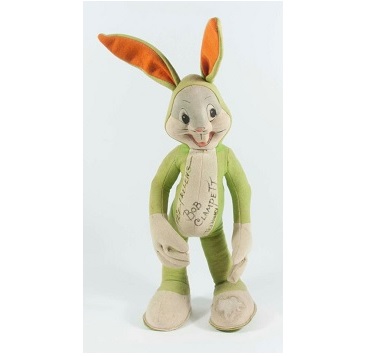
Toy Name: Bugs Bunny
Maker: Unknown
Year of Make: 1930s
Country of Origin: Unknown
While many around the world are familiar with the Looney Tunes cast today, there was a brief period of time when we might not have gotten to see them at all. After Harman and Ising left Warner Bros. in 1933 due to a budget dispute, they took their characters with them. For a while only the new character Buddy remained on the show – until Schlesinger brought in Tex Avery, Friz Freleng, and Bob Clampett to work on the series.
Porky Pig and Beans then made their debut appearance in I Haven’t Got a Hat (1935), with more iconic Looney Tunes favourites following:
- Daffy Duck in Porky’s Duck Hunt (1937)
- Elmer Fudd in Elmer’s Candid Camera (1940)
- Bugs Bunny in A Wild Hare (1940)
- Tweety in A Tale of Two Kitties (1942)
Bugs Bunny (seen here in the form of a felt and fabric doll signed by Avery, Freleng, and Clampett) was a breakout superstar, and the series moved from black and white to colour production to keep up with popular demand.
They also moved from showcasing music to depicting rough-and-tumble slapstick comedy – differentiating it from Disney’s cuter approach. Being seen as a more ‘adult’ cartoon helped Looney Tunes gain popularity, although it would gradually become more kid-friendly over time. The offensive and racial stereotyping featured in some of its earliest cartoons has earned the franchise some criticism, but Warner Bros. has since included disclaimers in home media acknowledging these stereotypes.
Golden Age: 1940s-1960s
As Looney Tunes gained popularity, the cast quickly expanded with more notable debuts:
- Pepe Le Pew in Odor-able Kitty, Sylvester in Life with Feathers, and Yosemite Same in Hare Trigger (all 1945)
- Foghorn Leghorn in Walky Talky Hawky (1946)
- Marvin the Martian in Haredevil Hare (1948)
- Wile E. Coyote and the Road Runner in Fast and Furry-ous (1949)
- Granny in Canary Row (1950)
- Speedy Gonzales in Cat Tails for Two (1953)
- Tasmanian Devil in Devil May Hare (1954)
A major part of the franchise’s popularity was voice actor Mel Blanc, who voiced almost every single character except Elmer Fudd, Road Runner, and Granny!
Return to the small screen: 1970-1999
Following the end of the original Looney Tunes (1930-1969) theatrical series, the franchise saw a resurgence in popularity following resyndication on popular TV networks such as Nickelodeon. Many of us may also remember growing up watching spin-offs like Taz-Mania (1991-1995) or The Sylvester & Tweety Mysteries (1995-2000).
And of course, no Looney Tunes retrospective could ignore their 1996 box office smash hit Space Jam, a sports comedy film which blended live action and animation. At the time this technology was still brand new, and the movie received critical acclaim for its technological advancements on top of its popular reception.
Worldwide Icons: The 2000s
Since entering the 21st century, the Looney Tunes gang has continued to appear in syndicated shows on Cartoon Network and HBO Max such as Baby Looney Tunes (2001-2006), Duck Dodgers (2003-2005), and Looney Tunes Cartoons (2019- now).
The worldwide impact of Looney Tunes cannot be overstated. It’s become a major global franchises with theme parks, toys, memorabilia, video games, comic books and more all dedicated to its rambunctious cast. Looney Tunes shorts have been nominated for and won Academy Awards, with 4 shorts being inducted into the National Film Registry.
Bugs Bunny in particular has become a true cultural icon, becoming seen as a representation of the ‘trickster’ trope and archetype in cartoons. Bugs has received a Hollywood Walk of Fame star – making him the second cartoon character to do so after rival Mickey Mouse – and even done commercials for Nike.
Looney Tunes continues to be one of the most popular cartoon franchises today, beloved by millions across the globe. Our museum’s Characters collection on level 4 even has an extensive Looney Tunes toy collection every Looney Tunes fan needs to see!
Interested to find out more about your favourite childhood cartoons? Want to catch a glimpse of nostalgic 80’s vintage toys? Book your ticket and see some of the best loved vintage toys including Looney Tunes and more at the MINT Museum of Toys!
The British Raj … As Told By Valuable Historical & Vintage Toys
The British Raj refers to the period between 1858 to 1947 when the Indian subcontinent was under the colonial rule of the United Kingdom. The area governed under the Raj included the modern sovereign states of India, Pakistan, and Bangladesh – however at the time, “India” or the “Indian Empire” was used as an umbrella term to refer to the entire region.
The UK had already seized control over parts of the region as early as 1757, when the British East India Company (BEIC) obtained dominion control over parts of Bengal. Following the Indian Rebellion of 1857 (also known as the Sepoy Mutiny, Indian Mutiny, or First War of Independence), the BEIC’s rule was dissolved with its powers transferred back to the British Crown. This was what officially began the period known as the British Raj, with a special India Office created to oversee governance.
The British Raj brought indelible changes to the subcontinent’s political, economic, and social spheres – for better and for worse. Though the economy grew at a rate of 1% per year, a majority of these earnings went into the pockets of British colonial rulers and administrators rather than Indian colonial citizens, and colonial mismanagement also led to widespread famines.
Conservative pro-British views also led to a rise in Orientalist depictions of India, and an erosion of traditional Indian imagery and symbolism as these were derogatorily seen as ‘backwards’ compared to ‘sophisticated’ British culture and history.
Discover the myriad impacts of the British Raj through these 3 valuable historical and vintage toys:
1. Hindu-Reiner Indien-Tee
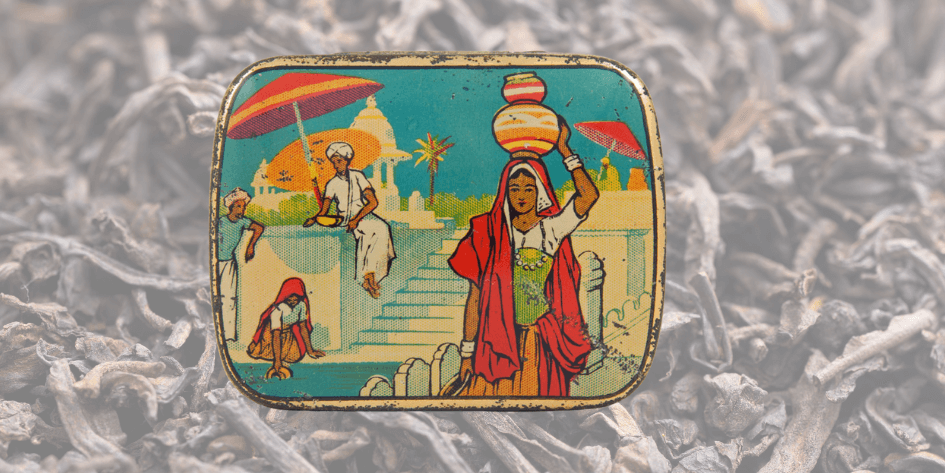
Maker: Pfannkuch G.m.b.H und Company
Year of Make: 1920s
Material: Lithographed Tin
Country of Origin: Germany
The BEIC shipped tea tins and spice boxes like this Hindu-Reiner Indien-Tee worldwide, carrying both the subcontinent’s most valuable natural resources and the cultural impact of the British Raj. As many everyday items such as postcards began to come out of British India, the imagery on them was also influencing popular ideas of South Asia and South Asian people throughout the world. However, these decorations depicted a flattened and exoticised Oriental India with various traditional customs blended into a singular ‘Indian culture’ by the undiscerning British.
The British also sanitised these images in line with their own morality, with long-lasting consequences till today. For example, the sari was not traditionally worn with a blouse, but this change was made during British rule as the British viewed it as vulgar and improper. Till today, many women still wear blouses under their saris although there is a growing awareness of the traditional history behind the garment.
Curious to see more? This vintage biscuit tin can be found in our Vintage Biscuit Tins collection located on the 5th floor rooftop stairwell. Visit our museum today to see them all!
2. Snakes and Ladders
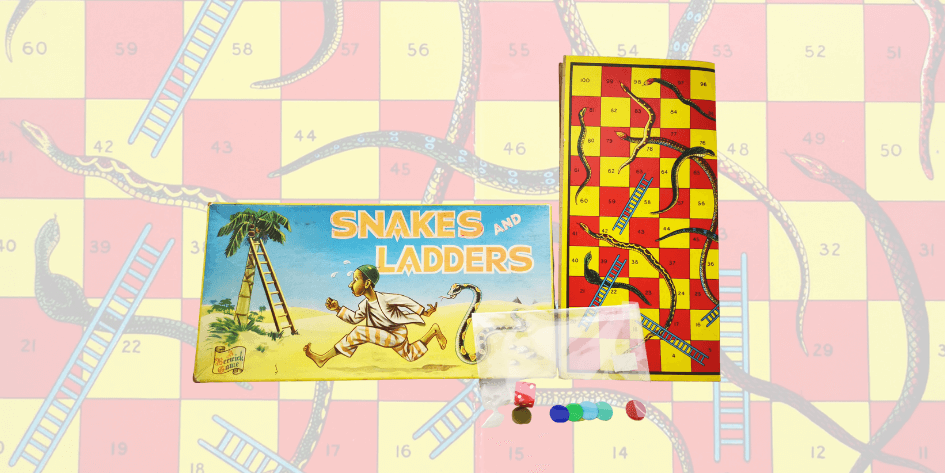
Maker: Berwick’s Toy Co. Ltd.
Year of Make: 1950s
Material: Printed Cardboard
Country of Origin: United Kingdom
Derived from the ancient Indian dice game Gyan Chauper or Gyan Chaupar, Snakes and Ladders originally had deeper spiritual connotations and meanings. The central idea of the game was to move from lower to higher levels of spiritual enlightenment and show how karma affects one’s spiritual journey.
Colonialists during the British Raj originally adapted Gyan Chauper into morality games which had a similar spiritual undertone, but during World War II the morality aspect was removed so companies could print simpler numbered game boards. Following World War II, the secular game Snakes and Ladders became popular worldwide – with few understanding its real origins.
3. Flying Aeroplane Chess

Maker: Trademark = Horse with wings
Year of Make: 1950s
Material: Wood and Paper
Country of Origin: China
Sometimes known as ‘Chinese Checkers’, Flying Aeroplane Chess was originally the ancient Indian game Pachisi. Descriptions of Pachisi can be found even in the Mahabharata, a text compiled between 3rd century BCE and 3rd century CE.
The original game was more elaborate than its contemporary counterpart, with cowrie shells determining how many steps a piece could move and capturing mechanisms for opposing pieces. In some royal courts it even served as a display of wealth and power, with life-sized boards and courtiers or slaves as the players.
However, these grand origins were largely forgotten after the British adapted Pachisi into Ludo during the British Raj, a simpler game with more straightforward mechanisms. Visit our Collectables collection on level 2 to take a look at both this Flying Aeroplane Chess game and vintage Snakes and Ladders game in-person!
Discover History through Vintage Toys
Vintage toys and memorabilia offer us a rare and valuable glimpse into the past, seeing how major historical events could trickle down into everyday objects. These 3 toys are just some of the pieces in the MINT Museum of Toys collection that reveal the widespread influence of the British Raj and its mixed effects on local Indian culture.
Book your tickets or sign up for a virtual museum tour to see more of our collections and exhibitions before you book an actual visit. The Collectables virtual tour even includes an interactive Snakes and Ladders game that’s fun for children and adults alike!
The Cultural Revolution (formally known as the Great Proletarian Cultural Revolution) was a major sociopolitical event in the history of modern China. The period lasted between 1966 to 1976, but its effects can still be felt today – decades on from the massive political upheaval and unrest that it caused.
One way we can get a glimpse into the past to better understand what life during the Cultural Revolution was like is through looking at the historical toys, collectibles, memorabilia, and other everyday items produced during that time.
Sociopolitical Change
The origins of the Cultural Revolution were primarily ideological, with the intention to root out bourgeoise elements and corruption present within Chinese society and government at the time. The end goal of the revolution was to return to a culture with a stronger focus on the rural everyday life of the proletariat.
Though the Cultural Revolution greatly impacted the lives of all Chinese citizens at the time, youths and students in particular were strongly involved and even encouraged to participate. They were encouraged to rebel against party officials perceived or deemed to be anti-communist or corrupt, with many forming student-led paramilitary Red Guard groups across the country.
The Red Guards were personally supported by then-Chairman Mao and this bolstered their confidence till their activities quickly extended beyond rooting out corruption to destroying ‘pre-communist’ representations of China. Deemed the “Four Olds” – Old Ideas, Old Culture, Old Customs, and Old Habits – this included temples, historical artifacts, books, paintings, and art works amongst others. Much of this was carried out by the Red Guards without formal government recognition (and the Chinese government even protected certain archaeological discoveries made during this time) but it resulted in massive destruction and disruption of everyday lives regardless.

Name: Communist boy with Little Red Book
Maker: Unknown
Year of Make: 1966-1976
Material: Vinyl
Country of Origin: China
In their place, figures similar to this Communist boy with Little Red Book toy were created to commemorate this new ideological shift. Artists adopted a style of “revolutionary romanticism” which depicted romanticised imagery of youth, war, and agrarian rural life.
Many of these unmarked figurines were displayed in homes or workplaces – serving as a signal that the owner was aligned to the new ideological standards. Ironically many figurines made from ceramic were created using traditional Chinese ceramics knowledge, but these were seen as ‘bringing new stimulus to the old tradition’.
Economic Revolution
Another objective of the Cultural Revolution was to achieve Chinese self-sufficiency and reduce dependency on foreign imports by encouraging industrial and agricultural activity. Education at almost every level shifted from formal education in schools to labour, practical, or industrial work in rural fields and factories.
This resulted in a major change in the daily lives of children as many families were forcibly relocated to rural towns and villages. Industrial and agricultural motifs were also incorporated into popular culture, ranging from books to household items to toys.

Name: East is Red Tractor
Maker: Unknown
Year of Make: 1960s
Material: Lithographed Tin, Plastic, Celluloid, and Rubber
Country of Origin: China
Toys like the East is Red Tractor were extremely common with the subtle goal of encouraging children to want to become farmers, truck drivers, and other blue-collar workers when they grew up. The tractor is based on the Dongfanghong 54 crawler tractor – the first tractor domestically produced in postwar China which was based on the Soviet DT-54 chain tractor. This battery-powered toy could be controlled via wired remote, allowing the tractor to move forwards, backwards, left, and right.
Following Mao’s death in 1976 and the end of the Cultural Revolution, many objects from the era were destroyed out of public anger at how much the Cultural Revolution had upset their lives. Genuine historical artifacts from the Cultural Revolution are now difficult to find – making it even more momentous that these vintage toys have survived till today.
You can now see a wide variety of historical and vintage toys from the 19th century till now at the MINT Museum of Toys.
Book your museum tickets online before coming to view our collections in-person or take our virtual museum tour to catch a glimpse of our Collectables and Childhood Favourite collections from anywhere in the world – including more memorabilia from Cultural Revolution China as part of the Collectables collection!
If you’re paying our premises a visit, you can also enjoy our brand-new XperienceAR Museum – an AR-based museum experience like you’ve never seen before.
Plastic toys are all around us today – but they’re actually a relatively new addition to the toy world! While some plastic toy lines such as Barbie dolls or G.I. Joe action figures are part of our cultural landscape now, even the iconic Barbie hasn’t hit the big 1-0-0 yet.
Join us as we discover the origin of plastic toys:
The Origin of Plastic Toys
Pre-World War II vintage toys were made from wood or metal with pricier toys and collectibles made from porcelain, ceramic, or ivory. However following World War II there were global shortages of metal and wood leading to toymakers seeking out cheap alternatives so they could mass produce toys and take advantage of the new post-war consumer culture.
Technological advancements in post-war scientific research quickly led to the invention of new materials like thermosetting plastics and new polymers like polystyrene and polyethylene. These could be quickly, cheaply, and easily dyed or moulded, making them perfect for mass production.
As Germany – which had been the leading global toy manufacturer prior to the war – was still recovering, the USA quickly filled the void with companies like Hasbro and Mattel gaining worldwide popularity.
Brand Showcase: Hasbro
Hasbro was originally founded in 1923 and started out as a textiles and stationery supplies company. The company switched to toymaking in the early 1940s and quickly embraced plastic toys post-World War II. The company has since produced dozens of plastic toy franchises including Mr. Potato Head, My Little Pony, and Littlest Pet Shop.

Maker: Hassenfeld Bothers Incorporated (Hasbro)
Year of Make: 1964
Material: Plastic, Fabric
Country of Origin: United States of America
Hasbro’s most popular plastic toy is definitely the G.I. Joe action figure. The original G.I. Joe (like this G.I. Joe – Action Soldier) came in 4 builds to represent the 4 branches of the US Armed Forces, and his appearance has changed over the years in response to societal attitudes regarding war and the military.
While this toy is not on display at our museum at the moment, we do rotate our displays every 6 months so keep your eyes peeled for more! G.I. Joe fans can also view a selection of G.I. Joe toys at our seasonal exhibition UNBOX Presents: Toy Figurines.
Brand Showcase: Mattel
The other biggest name in the plastic toy industry is definitely Mattel. Founded in 1945 the company started out selling picture frames before moving onto dollhouse furniture and finally toys. Notable plastic toys by Mattel include Barbie, Chatty Cathy, Hot Wheels, American Girl, and Polly Pocket.

Maker: Mattel, Inc
Year of Make: 1959
Material: Plastic, Vinyl
Country of Origin: Japan
Arguably the most influential plastic toy till date, Barbie has been a staple of Mattel’s wheelhouse since the first Teen-age Fashion Model was introduced in 1959. An estimated 350,000 Teen-Age Fashion Model dolls were sold in its first year of production alone!
Featuring a black and white swimsuit designed by Mattel fashion designer Charlotte Johnson, Barbie stood out amongst other children’s toys with her fashion-forwardness. A fun fact you might not know is that many early Barbie dolls were manufactured in Japan and their outfits hand-stitched by Japanese homeworkers! This was due to the low cost of Asian labor during that era, although Mattel has since diversified their production line.
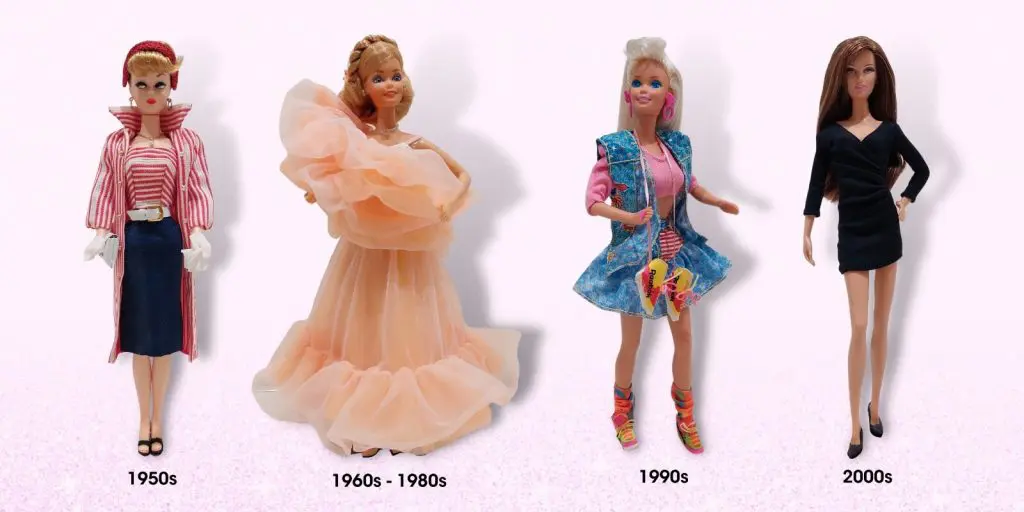
Fans of Barbie can view a huge exhibition of this iconic doll in our UNBOX Presents: Toy Figurines event as well, featuring Barbies from the 1950s till today.
Plastic Toys Today
While plastic toys are still commonplace today, attitudes are now changing due to environmental and health and safety concerns. These concerns range from potential toxins to the inability to recycle multi-part plastic toys. New innovations in the industry have sought to resolve these issues, from the introduction of bioplastics to some toy lines completely eliminating plastic materials or packaging.
Regardless, plastic toys remain an important testament to the changing toy and memorabilia landscape over the years as well as a peek into larger historical events. Pay a visit to our toy museum in Singapore to see more of your best loved plastic toys or book a guided tour to our UNBOX event for a deeper dive into your favourite vintage and contemporary figurines.
It’s difficult for many of us today to comprehend just how different the world was after the end of World War II with the advent of the Cold War, Space Race, and Atomic Age. Politically, economically, socially, and even technologically, everything seemed to be in flux and uncertain.
Nowhere were these societal anxieties better discussed and interpreted than pop culture. From The Twilight Zone to X-Files, the science fiction genre in particular has always been a way for creators to let their imaginations run free and imagine what the changes in our present could mean for the future.
Even kids weren’t insulated from these discussions, as two of the 1960s most popular TV shows – The Flintstones and The Jetsons – show. Though we can look back on these 2 series through the lens of childhood nostalgia, they were actually a poignant vehicle for examining and critiquing wider issues within American society.
Read on to find out more!
Who were the Flintstones and Jetsons?
Running from 1960 to 1966, The Flintstones was a family sitcom cartoon set in a fictionalised Stone Age. The Jetsons was their futuristic counterpart which aired between 1962 to 1963, and 1985 to 1987. Both were produced by the beloved Hanna-Barbera company behind many of our childhood favourites.
Both shows revolved around the antics of the eponymous Flintstone and Jetson families as they ran into everyday problems and hilarious scenarios. Characters like Fred and Wilma Flintstone, Barney and Betty Rubble, Dino, George and Jane Jetson (and their kids Elroy and Judy), and Rosey the robot are still cultural icons decades later and are fondly remembered in our childhood memories.
Seeing the Present through the Past and Future
While both shows seemed years apart (literally), they actually used their respective settings as a way to poke fun at American culture.
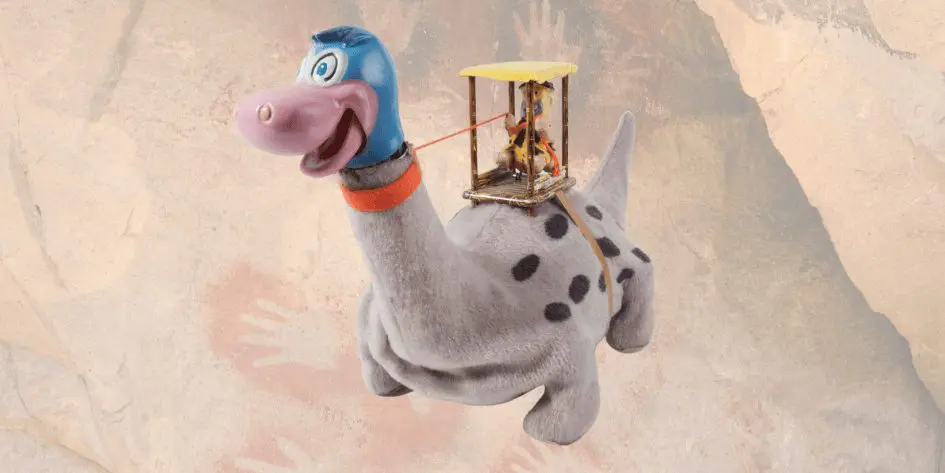
Pictured: “Dino”
Maker: Louis Marx and Company
Year of Make: 1962
Material: Fabric, Plastic, and Lithographed Tin
Country of Origin: Japan
The Flintstones leaned heavily into anachronistic humour and references – think stone cars powered by foot, or the suburban rock houses that the Flintstones and Rubbles lived in. Plot-wise many of the Fred and Barney’s hijinks were similar to that of contemporary live-action sitcomes – they would get into trouble, find a way out of it, and be reprimanded or laughed at by Wilma and Betty at the end of the episode.

Pictured: “Somersaulting Tank”
Maker: Unknown
Year of Make: 1960s
Material: Rubber and Lithographed Tin
Country of Origin: China
In comparison, the Jetsons combined everyday problems with the futurism of science fiction for exaggerated comic effect. Typical sitcom hijinks were made even more unbelievable through their futuristic gizmos and gadgets – such as Rosey the robot complaining about how tired she is from doing chores all day.
Despite their out-of-this-world settings, both sitcoms tackled anxieties over whether new and emerging technology could actually solve our problems and even suggested that mundane problems of daily life would stay the same.
While they both poked fun at newly-emerging small town Americana life however, one reason why both series are still beloved today is the optimism and humour that ran through them. Most importantly, the neat endings and reconciliations at the end of every episode were a warm and optimistic reassurance that no matter what happens – or when – family would still be important.
Vintage shows such as The Flintstones and The Jetsons aren’t just a vehicle for entertainment but a kind of cultural time capsule. Through reflecting on them, we can learn valuable lessons about our past, present, and hopes for the future too.
Visit our toy museum in Singapore to see more vintage collectible toys and memorabilia and see history in a whole new (fun) way!
Here at the MINT Museum of Toys, we strive to not only bring you a world-class collection of vintage and historical toys and memorabilia, but to provide exhibition spaces for creative pop ups, workshops, and events in Singapore. We understand the passion that goes into toy and memorabilia collections, and want to give toy collectors a chance to commemorate their years of effort and dedication.
Our UNBOX programme was designed to help us do just that! UNBOX comprises seasonally-rotating themed exhibitions and pop ups that are meant to provide private collectors and international brands alike with a creative space to explore alternative exhibition narratives through valuable toys and memorabilia.
UNBOX is always open to toy enthusiasts and collectors who want to showcase their collection to a wider audience. Toy connoisseurs can browse our UNBOX Exclusive Archive of merchandise to fill your display cases with.
UNBOX Presents: Toy Figurines
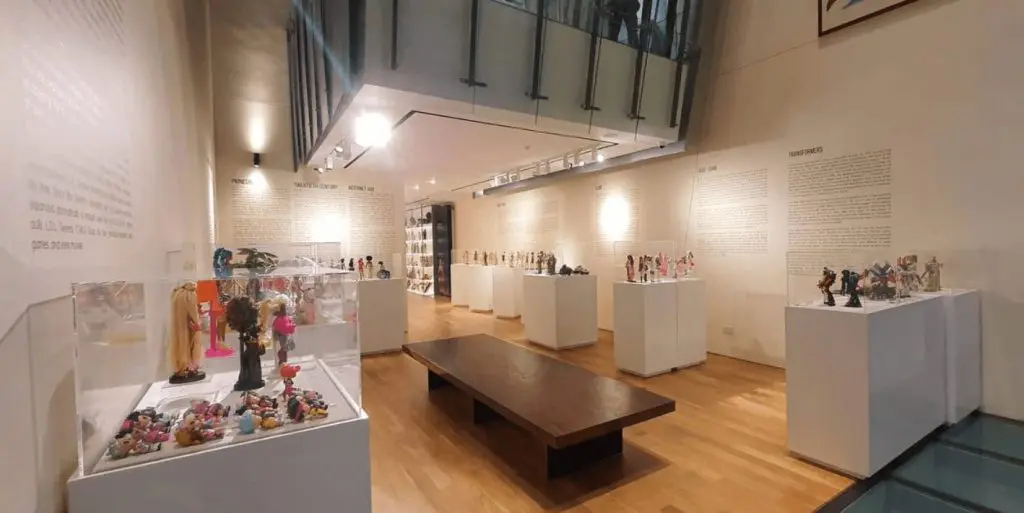
Our current UNBOX event – UNBOX Presents: Toy Figurines – pays tribute to iconic toy figurines that have sparked and spanned generational shifts. Through this exhibition, you can learn how toy figures have always pushed the limits of societal expectations by giving kids creative new ways of seeing, imagining, and dreaming of the world around them.
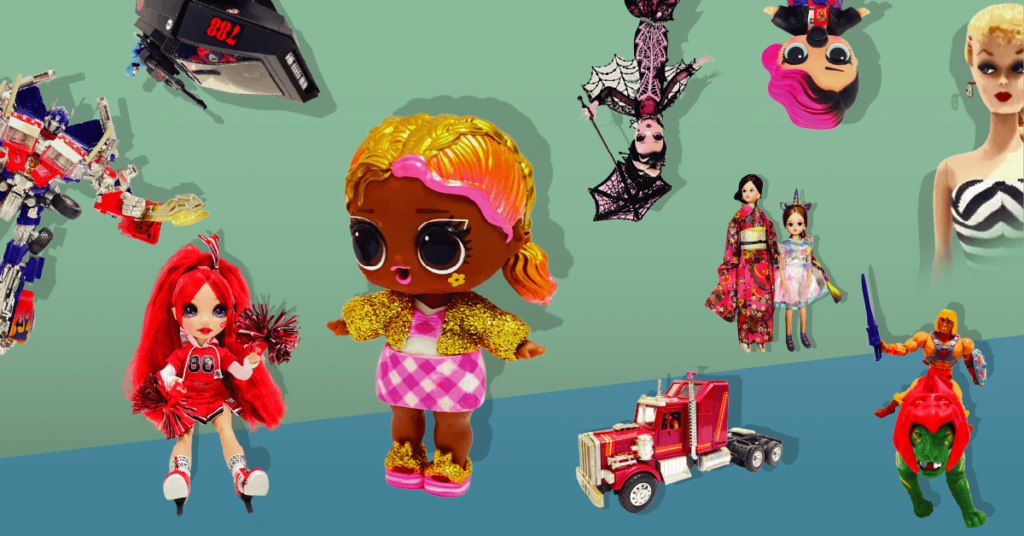
The exhibition covers toy figurines and dolls from 10 brands in total: Barbie, G.I. Joe, M.A.S.K, He-Man, Bratz, Monster High, Rainbow High, Licca Chan, Transformers, and L.O.L. Surprise. Trace the journey of dolls and figurines throughout the decades – from the first Barbies of the 1950s and 1960s to the racially-diverse Bratz dolls that dominated in the early 2000s to today’s boundary-pushing Monster High and Rainbow High dolls that openly tackle once-taboo topics such as LGBTQ+ rights.
UNBOX Presents: Popeye & Vintage-Inspired Timepieces
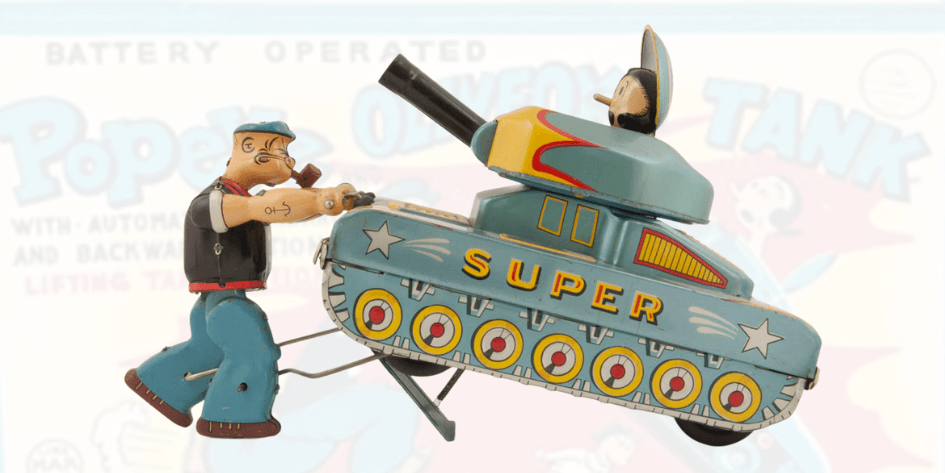
Our latest exhibition – UNBOX Presents: Popeye & Vintage-Inspired Timepieces – celebrates Popeye the Sailor Man, who was first introduced to the public in a comic strip in 1929 and quickly became a crowd favourite. Private collectors with a passion and love for all things vintage can expect to see a range of rare and valuable pieces that we have specially curated for this pop up event.
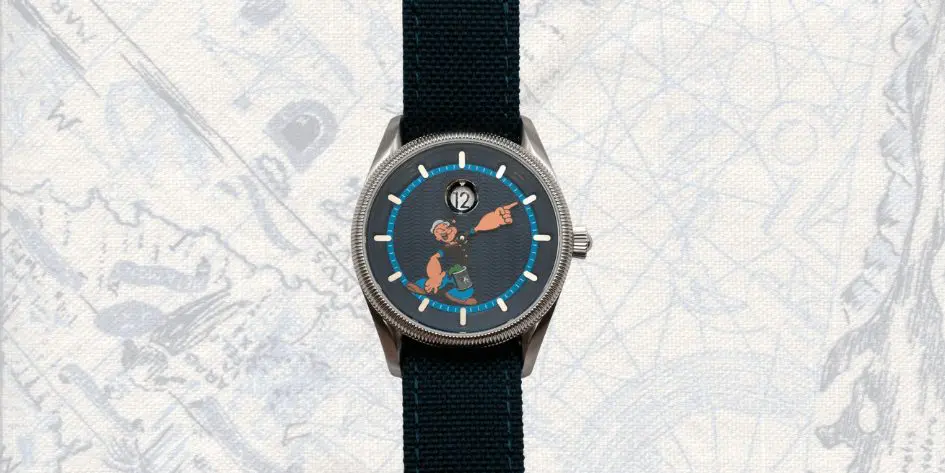
The creative space will showcase two Popeye vintage toys, the Popeye and Olive Oyl Tank as well as the Popeye Heavy Hitter, from our own collection at the MINT Museum of Toys. In collaboration with local artist and watch maker, Ivan Chua, the Founder of Vario, the exhibition will feature The NAVI x Popeye Jump Hour Watch amongst other popular timepieces from the brand. Inspired by nautical elements present in the story and character, the watch features distinct and creative details such as an optical lens that sits as a water droplet to magnify the hour markers. A collection of 1918 Trench Watches and a series of Empire Art Deco Watches will also be on display at the event space, paying homage to the World War I and post-war era.
UNBOX isn’t just a venue for collection showcases or toy-themed pop ups, but a creative space where larger questions about art, culture, and everyday life collide and how toys and playthings can tell us more about ourselves and each other. Our UNBOX programme offers collectors and toy enthusiasts unique networking opportunities, access to our vast resources and collections, as well as new creative experiences and participation opportunities with the niche but growing collector’s scene.
Get in touch to find out more about our UNBOX programme, private event space rentals, creative workshops, and more right here in Singapore.
